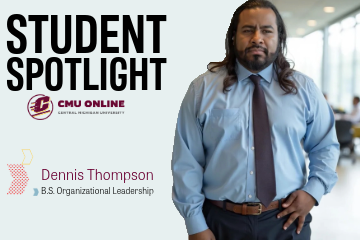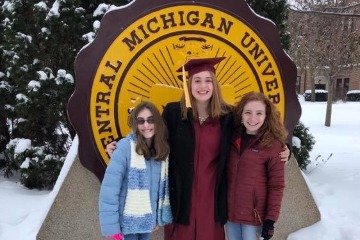CMU dean answers pressing questions about teaching and education
The state of teaching has been a focus of national conversation for the past few years. New findings from the Merrimack College Teacher Survey, which polled more than 1,300 teachers nationwide, spotlight the struggles facing a workforce exhausted from more than two years of pandemic teaching.
Paula Lancaster, Dean of the College of Education and Human Services at Central Michigan University, shared her thoughts on some of the most pressing issues facing education today – and how CMU is preparing future educators to be a part of the solution.
Q: As we begin to move into teaching post-pandemic, what is the current state of teaching, especially in Michigan?
A: Moving out of COVID is a welcome relief, but some challenges remain. First, we are facing significant teacher and leader shortages that will have serious consequences for children and youth, particularly in low-resourced communities. We do need to acknowledge that the pandemic did not cause the decline in interest in teaching, and moving out of it won’t solve the shortage issue either. I’m immensely grateful for the leadership of the Michigan Department of Education for proposing comprehensive legislative and policy changes that will turn the tide if implemented. Getting these changes enacted will require collaboration across the educational enterprise and the support of non-educators as well.
Here at CMU, we are seeing some increases in enrollment in our preparation programs and hope to see greater increases in the coming years. We’re thrilled to welcome these students who are interested in impacting the lives of others, into this wonderful field. They are inspirational and remind us of the bright future ahead! We are committed to providing them with excellent preparation and supporting them as they begin their careers.
Second, we are uncertain about the mid- and long-term impact of COVID on the health, development, and well-being of children and youth. We know we will need to invest significant time and focus on supporting young people as we transition into post-pandemic life. The pandemic has reminded us how important teachers and human connections are for children and youth. We’ve also seen glaring examples of the inequities that exist in educational opportunities offered to students depending on where they live. These inequities have always been there, but the pandemic shined a spotlight on them. As we consider a return to post-pandemic life, we must stay committed to dismantling inequities that hold far too many children in our state back from reaching their full potential. I’ve never seen the widespread and deep level of attention to these issues that have been happening post-pandemic. While the increased level of awareness is great, the real, hard work is in making change happen.
Third, I think we all appreciated the focus and attention on teaching during the pandemic. Hearing people speak about how much they valued the work teachers and administrators do was refreshing. As a society, we need to take that gratitude and channel it into tangible value in order to continue to attract young people to this incredibly important work.
Q: The teacher shortage and teacher burnout have been at the center of that conversation. How does the industry address these issues in the short- and long-term?
A: We need to invest in a bit of a market correction, which would ensure that teacher salary and benefits, particularly for early career teachers are sufficient to attract talented educators. We also need to invest in educational support staff such as counselors, social workers, instructional coaches, and paraprofessionals. In the short term, I favor financial support for teacher candidates during their student teaching semester. Thought and consideration need to be put into how we do this well, but I do feel the timing is right for such a change. Raising salaries for teachers would also help tremendously. Young adults have many career options that pay considerably more than teaching and without many of the current challenges. Our society needs to better understand the value that a highly educated workforce and teaching force brings.
Working conditions are an issue, too. Most teachers in U.S. public schools do not have sufficient planning and collaboration time, particularly compared to their counterparts in other countries. Being the sole adult in the room day in and day out means that the work can feel a bit isolating. Collaborative time with peers is essential to plan, adjust, share ideas, and problem solve. Working conditions is another area in which inequities between well- and low-resourced schools are particularly problematic.
Q: How is the training of teachers changing for the current demands of the industry?
A: The field is moving toward a more practice-based approach, which means that teacher candidates will come to their first classroom with significantly more skill and clinical and field experiences than what was required in years past. Additionally, we are focused on ensuring a high level of skillfulness in equitable and inclusive practice along with a deeper understanding of the importance of social and emotional well-being and the building of respectful relationships with and among children and youth. Another change we’re seeing is an acknowledgment that the context in which schooling takes place matters greatly, and understanding the assets and strengths in a community is crucial for student success.
With regard to industry, I’m not sure the direction our field is heading has ever been more aligned to the industry as we are right now. I say this because as we prepare teachers, we are shifting from a strong focus on discrete content knowledge to a focus on the application of knowledge. We want teaching to support critical thinking, reasoning, and decision-making and to build communication and collaboration skills. Ideally, instruction is less focused on seeking the right answers from some students and more interested in surfacing the thinking, understanding, brilliance and contributions of all students.
Q: What is CMU doing to lead these innovations?
A: We’re excited about new programs that we offering and the impact these programs are already having on students who are enrolled in them. We are leading the way in special education and disability studies, and our students are well-prepared to serve and improve access across many environments and classrooms. We’re also very excited about technology use, such as avatar-based simulations and video observations, which afford our candidates new and enhanced ways to improve their practice. Our faculty have continuously pushed the envelope in their research and excellence in the classrooms, winning awards across the campus and earning professional recognition nationally.
Q: What does the future hold for the industry?
A: The use of technology will continue to increase, but it will always be a tool that requires a deep understanding of instructional design and practice in order to be effective. Professional educators possess that deep understanding and are constantly working to develop effective and improved ways to teach. Learning science, the science of expertise, and knowledge around the connections between social and emotional well-being and learning are all areas of study that are growing and informing educators.
Now is an incredibly exciting time to study teaching as we know so much more about how cognition works and is best supported. We have a much better understanding of behavior and why humans do the things we do, particularly as it relates to trauma and feelings of safety. We know that effective teaching will require a wide range of approaches and significantly more collaboration among professionals.
Finally, we all bring a particular lens to the classroom, often based on our past experiences, which inform our expectations for our students and preferences for our teaching. Recognizing the ways in which our past experience might lead to assumptions and biases about children and youth and checking to ensure that we are affording dignity and respect to all children is a significant and powerful change occurring in teacher education. This change is likely the most important one of all.
About Paula Lancaster
Dr. Paula Lancaster began her role as the Dean of the College of Education and Human Services at Central Michigan University in July 2020.
She is a professor of special education and has served in the roles of Department Chair and Director of Teacher Education. After receiving her B. S. in Special Education, she was a high school special education teacher for eight years. During this time, she completed her M.S. in Curriculum and Supervision and a certification in Educational Leadership while becoming a building-level administrator. She completed her Ph.D. in Special Education in 1999 at the University of Kansas, where she also worked at the Center for Research on Learning.
Her research has focused on effective instruction and instructional technology for adolescents with high incidence disabilities. Recently, her work is centered on the development and implementation of practice-based approaches to educator preparation with a particular interest in collaborations between university-based preparation programs and P-12 school environments. She is active in state-level educator preparation work, serving on multiple committees and task forces, and is a founding member of the Michigan Teacher Education Network, an organization dedicated to disrupting patterns of inequity in teaching and teacher education.
Media outlets wishing to speak to Dean Paula Lancaster can contact Aaron Mills, director of communications, at millsac@cmich.edu or 989-774-1197.




